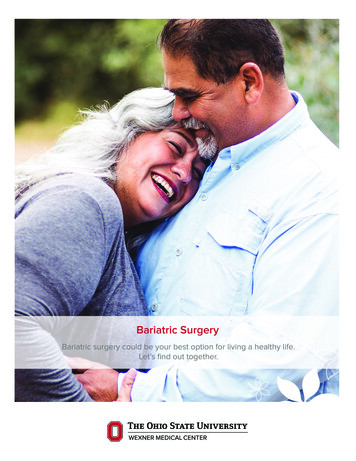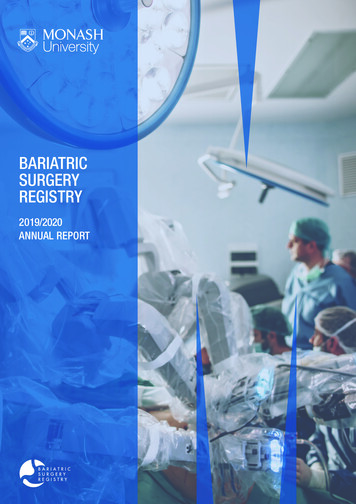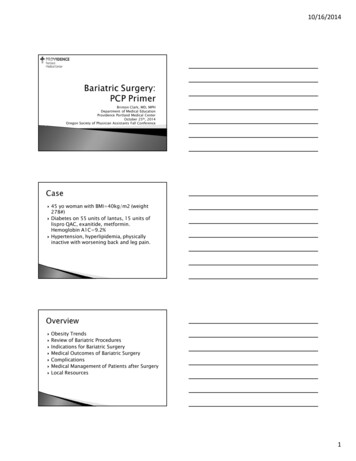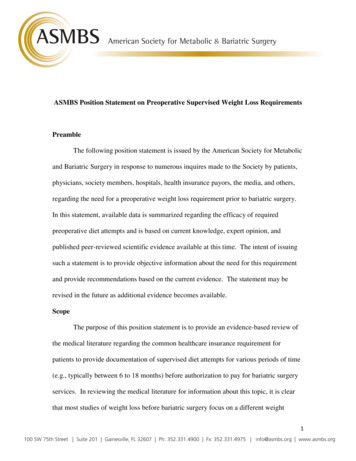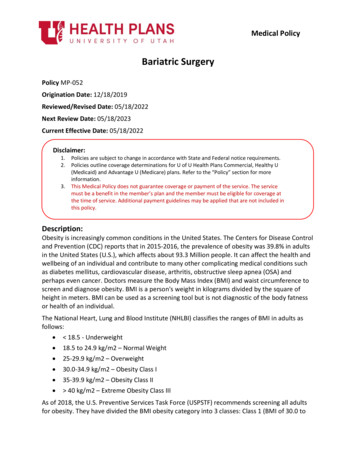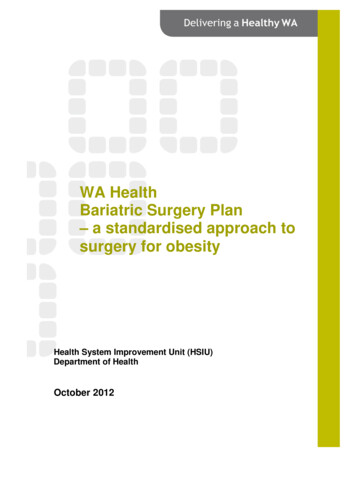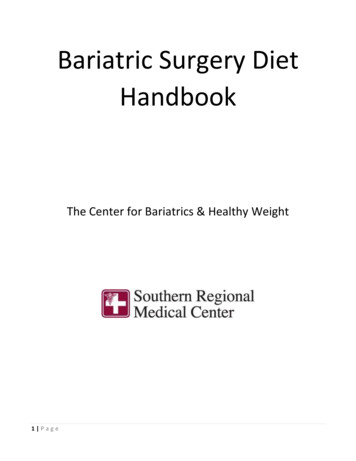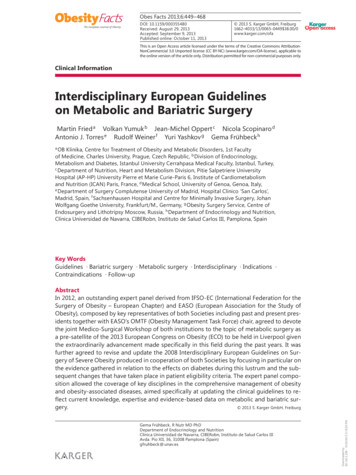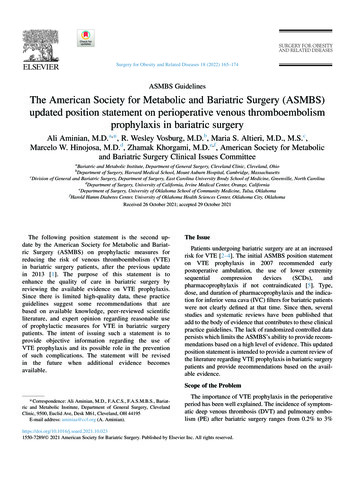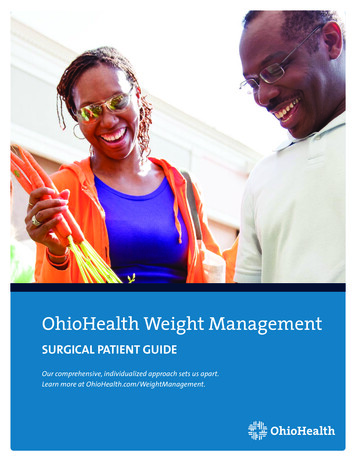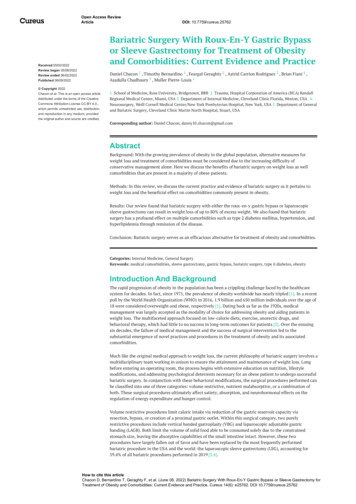
Transcription
Open Access ReviewArticleDOI: 10.7759/cureus.25762Bariatric Surgery With Roux-En-Y Gastric Bypassor Sleeve Gastrectomy for Treatment of Obesityand Comorbidities: Current Evidence and PracticeReceived 05/02/2022Review began 05/08/2022Daniel Chacon 1 , Timothy Bernardino 1 , Feargal Geraghty 2 , Astrid Carrion Rodriguez 3 , Brian Fiani 4 ,Asadulla Chadhaury 5 , Muller Pierre-Louis 1Review ended 06/02/2022Published 06/08/2022 Copyright 2022Chacon et al. This is an open access articledistributed under the terms of the CreativeCommons Attribution License CC-BY 4.0.,which permits unrestricted use, distribution,and reproduction in any medium, providedthe original author and source are credited.1. School of Medicine, Ross University, Bridgetown, BRB 2. Trauma, Hospital Corporation of America (HCA) KendallRegional Medical Center, Miami, USA 3. Department of Internal Medicine, Cleveland Clinic Florida, Weston, USA 4.Neurosurgery, Weill Cornell Medical Center/New-York Presbyterian Hospital, New York, USA 5. Department of Generaland Bariatric Surgery, Cleveland Clinic Martin North Hospital, Stuart, USACorresponding author: Daniel Chacon, danny10.chacon@gmail.comAbstractBackground: With the growing prevalence of obesity in the global population, alternative measures forweight loss and treatment of comorbidities must be considered due to the increasing difficulty ofconservative management alone. Here we discuss the benefits of bariatric surgery on weight loss as wellcomorbidities that are present in a majority of obese patients.Methods: In this review, we discuss the current practice and evidence of bariatric surgery as it pertains toweight loss and the beneficial effect on comorbidities commonly present in obesity.Results: Our review found that bariatric surgery with either the roux-en-y gastric bypass or laparoscopicsleeve gastrectomy can result in weight loss of up to 80% of excess weight. We also found that bariatricsurgery has a profound effect on multiple comorbidities such as type 2 diabetes mellitus, hypertension, andhyperlipidemia through remission of the disease.Conclusion: Bariatric surgery serves as an efficacious alternative for treatment of obesity and comorbidities.Categories: Internal Medicine, General SurgeryKeywords: medical comorbidities, sleeve gastrectomy, gastric bypass, bariatric surgery, type ii diabetes, obesityIntroduction And BackgroundThe rapid progression of obesity in the population has been a crippling challenge faced by the healthcaresystem for decades. In fact, since 1975, the prevalence of obesity worldwide has nearly tripled [1]. In a recentpoll by the World Health Organization (WHO) in 2016, 1.9 billion and 650 million individuals over the age of18 were considered overweight and obese, respectively [1]. Dating back as far as the 1920s, medicalmanagement was largely accepted as the modality of choice for addressing obesity and aiding patients inweight loss. The multifaceted approach focused on low-calorie diets, exercise, anorectic drugs, andbehavioral therapy, which had little to no success in long-term outcomes for patients [2]. Over the ensuingsix decades, the failure of medical management and the success of surgical intervention led to thesubstantial emergence of novel practices and procedures in the treatment of obesity and its associatedcomorbidities.Much like the original medical approach to weight loss, the current philosophy of bariatric surgery involves amultidisciplinary team working in unison to ensure the attainment and maintenance of weight loss. Longbefore entering an operating room, the process begins with extensive education on nutrition, lifestylemodifications, and addressing psychological deterrents necessary for an obese patient to undergo successfulbariatric surgery. In conjunction with these behavioral modifications, the surgical procedures performed canbe classified into one of three categories: volume restrictive, nutrient malabsorptive, or a combination ofboth. These surgical procedures ultimately affect satiety, absorption, and neurohormonal effects on theregulation of energy expenditure and hunger control.Volume restrictive procedures limit caloric intake via reduction of the gastric reservoir capacity viaresection, bypass, or creation of a proximal gastric outlet. Within this surgical category, two purelyrestrictive procedures include vertical banded gastroplasty (VBG) and laparoscopic adjustable gastricbanding (LAGB). Both limit the volume of solid food able to be consumed solely due to the constrainedstomach size, leaving the absorptive capabilities of the small intestine intact. However, these twoprocedures have largely fallen out of favor and have been replaced by the most frequently performedbariatric procedure in the USA and the world: the laparoscopic sleeve gastrectomy (LSG), accounting for59.4% of all bariatric procedures performed in 2019 [3,4].How to cite this articleChacon D, Bernardino T, Geraghty F, et al. (June 08, 2022) Bariatric Surgery With Roux-En-Y Gastric Bypass or Sleeve Gastrectomy forTreatment of Obesity and Comorbidities: Current Evidence and Practice. Cureus 14(6): e25762. DOI 10.7759/cureus.25762
Malabsorptive procedures decrease the effectiveness of nutrient absorption by decreasing the length of smallbowel capable of food breakdown by one of two mechanisms. These mechanisms are either via bypass of thesmall bowel absorptive surface area, or diversion of the biliopancreatic digestive secretions that facilitateabsorption. Jejunoileal bypass (JIB) and biliopancreatic diversion (BPD) are examples of purelymalabsorptive procedures which result profound weight loss. However, due to their substantial metaboliccomplications related to malabsorption, utilization of these surgical interventions has been overtaken byprocedures that adopt qualities of both restrictive and malabsorptive approaches [3]. Procedures that utilizea combination of both restrictive and malabsorptive properties include the well-established Roux-en-Ygastric bypass (RYGB) and biliopancreatic diversion with duodenal switch (BPD/DS). Of these two, RYGB issecond only to the LSG as the most commonly employed bariatric surgery in the world, accounting for 17.8%of all bariatric procedures performed in 2019 [3,4].Here we will present and discuss the current practice of bariatric surgery, highlighting the surgical procedureand pre-operative requirements for candidacy. Followed by an extensive review and presentation of currentliterature reporting on the post-surgical outcomes as it pertains to efficacy on weight loss and beneficialeffects on comorbidities often present in obesity.MethodsOur literature search and selection criteria followed the PRISMA guidelines. We used a database of publishedopen access articles filtered by keywords including “post-surgical outcomes”, “bariatric surgery”,“comorbidities”, “roux-en-Y gastric bypass”, and “laparoscopic sleeve gastrectomy”, resulting in 54potential articles to include in our review.Inclusion criteria for our review consisted of articles reporting weight loss at multiple periods,postoperatively, and the effect of surgery on comorbidities, including type 2 diabetes mellitus, hypertension,and hyperlipidemia. Articles reporting on only one period were not excluded; however, the minimum periodpost-operatively was to be six months. Exclusion criteria consisted of articles of non-English language, nonhuman subjects, articles with less than six months postoperative follow-up, and articles including values onsurgical techniques other than Roux-en-Y gastric bypass (RYBG) and the LSG were not included in ourreview. A final count of articles used in our review totaled to 32.Surgical procedureThe American Society of Metabolic and Bariatric Surgery (ASMBS) currently endorses seven bariatricprocedures that health centers accredited by the American College of Surgeons Metabolic and BariatricSurgery Accreditation and Quality Improvement Program (MBSAQIP) may perform [5]. Here we will reviewthe general steps involved in the two most common surgeries- the laparoscopic sleeve gastrectomy (LSG)and the Roux-en-Y gastric bypass (RYGB). Note: certain steps involving patient positioning, prepping,draping, and closing have been omitted for convenience purposes.The restrictive sleeve gastrectomy was first performed laparoscopically in 1999 and has since become themost common bariatric surgery performed in the world, overtaking RYGB in 2015 [3,6]. The procedure isinitiated with the insertion of a trocar into the abdominal cavity just superior to the umbilicus utilizing aHassan or Optiview technique. Following appropriate insufflation, three to four additional trocars areintroduced under direct visualization with a 30-degree laparoscope. A liver retractor is often utilized forimproved visualization and avoidance of injury to hepatobiliary structures. Dissection and mobilization ofthe greater curvature and lesser curvature (or lesser and greater curvatures) of the stomach is then achievedwith the aid of laparoscopic energy devices. With the stomach completely mobilized, a 32 to 40 Frenchbougie is placed in the lesser curve segment prior to resection to maintain adequate lumen and achieve astandardized size of gastric remnant. With the bougie properly placed, an endoscopic GIA stapler isintroduced, stapling the stomach at a point proximal to the pylorus for preservation of the antrum and toallow for maintenance of gastric emptying. The staple lines are sequentially fired along the bougie towardthe angle of His and divide the fundus just lateral to the esophagus. Staple lines are often reinforced withsutures ensuring less chance of staple line leaks. Roughly 80% of the stomach is removed, with the fundusmaking up the largest portion of the excised specimen. The procedure is non-adjustable and non-reversible.The duration of the procedure is between 30 and 90 minutes, with an average 1-2 day stay in the hospitalpost-procedurally [3,6]. A view of the surgical procedure is shown on Figure 1.2022 Chacon et al. Cureus 14(6): e25762. DOI 10.7759/cureus.257622 of 13
FIGURE 1: Anatomical view of the sleeve Gastrectomy. (Original Artworkby Rogelio Avila)The restrictive-malabsorptive Roux-en-Y gastric bypass (RYGB) procedure was first performedlaparoscopically in 1994 [7]. The process begins in similar fashion to the sleeve gastrectomy, with entry intothe abdominal cavity via insertion of a trocar superior to the umbilicus utilizing the Hassan or Optiviewtechnique. Following appropriate insufflation, an additional four to five trocars are inserted under directvisualization with a 30-degree laparoscope. Once again, a retractor is often employed to increase gastricexposure and protect the liver and associated structures. After proper dissection and mobilization, the nextstep involves creation of the gastric pouch. The pouch creation involves multiple GIA linear staple firing tothe proximal stomach resulting in a closed, 20-30 cc pouch. The resultant large residual stomach is nowcompletely excluded from food entry via the esophagus. Next is the creation of the biliopancreatic (BP) -orafferent limb- which consists of the duodenum and proximal jejunum remaining in continuity with theremnant stomach. In a standard gastric bypass, approximately 40-50 cm is measured starting at theligament of Treitz and divided using a stapling device to create the BP limb. The roux, or efferent, limb issubsequently created. This limb which consists of mobilizing and measuring 75 to 150 cm of jejunum distalto the division point. The first anastomosis follows with the creation of the jejunojejunostomy. The BP limbis anastomosed to the distal segment of jejunum to create a side-to-side jejunojejunostomy, or theJJ anastomosis. The roux limb of the jejunum can then be brought up either in an antecolic-antegastric or aretrocolic-retrogastric orientation. A side-to-side gastrojejunostomy is created next by anastomosis of theproximal end of the mobilized jejunum to the gastric pouch. As in the LSG, staple lines involved in theanastomoses are reinforced with sutures to minimize the risk of staple leaks. The procedure takes 90-150mins with an average two-to-four-day hospital stay. Most centers employ a post-operative leak test within24-36 hours via an upper gastrointestinal series to rule out the presence of anastomotic leaks prior tohospital discharge [3,7]. A view of the surgical procedure is shown in Figure 2.2022 Chacon et al. Cureus 14(6): e25762. DOI 10.7759/cureus.257623 of 13
FIGURE 2: Anatomical View of the Roux-En-Y Gastric Bypass (OriginalArtwork by Rogelio Avila)Clinical indications and preoperative evaluation for bariatric surgeryMultiple steps are required for a patient to be considered a candidate for bariatric surgery. This processbegins with satisfying inclusion criteria related to body mass index (BMI) and obesity-associatedcomorbidities. According to the ASMBS and Society of American Gastrointestinal and Endoscopic Surgeons(SAGES) guidelines for bariatric surgery, the indications for weight loss surgery are as follows [8,9]: 1) BMI 40 kg/m2 with no comorbid conditions. 2) BMI of 35-39.9 kg/m2 with at least one serious comorbidity,including but not limited to type-2 diabetes mellitus, hypertension, obstructive sleep apnea (OSA),hyperlipidemia, obesity hypoventilation syndrome (OHS), Pickwickian syndrome, nonalcoholic fatty liverdisease, pseudotumor cerebri, or severe limitations on the quality of life-related to weight. 3) BMI of 30-34.9kg/m2 with metabolic syndrome or diabetes mellitus that is uncontrolled with medical therapy.It is also important to note that candidacy for bariatric surgery additionally depends on fulfilling the abovecriteria and those criteria decided per the surgical institution. This often entails the documented failure ofprevious non-surgical attempts at weight reduction and/or participation in a pre-operative guided weightloss program with exercise and lifestyle modifications [10]. In addition, certain commitments may also berequired by surgical programs to ensure the patient will abide by the postoperative nutritional restrictionsrequired to successfully achieve the desired weight loss. These commitments vary amongst the varioussurgical institutions but may include attending a mandatory information seminar on bariatric surgery,expectations of patient adherence to postoperative care, including follow-up visits with the surgeon andother members of the care team.As previously mentioned, the extensive pre-operative assessment encompasses a multidisciplinary team,often involving dieticians, psychologists, endocrinologists, nurses, anesthesiologists, and cardiologistsworking in conjunction with the surgical team to ensure a positive postoperative outcome [8]. Although thepreoperative workup and evaluation require tailoring unique to each patient, the following interventionshave become a mainstay in evaluating the comorbidities, expectations, and medical and psychologicalconcerns the patient may have.2022 Chacon et al. Cureus 14(6): e25762. DOI 10.7759/cureus.257624 of 13
A psychological evaluation is one of the first steps in preoperative evaluation. This involves screening for ahistory of mental disorder, depression, eating disorders, prior weight loss attempts, compliance withtherapy, and substance misuse. Centers may require documented smoking abstinence, as well as referral forrehabilitation and detoxification if alcohol dependence is identified, with subsequent documentation ofabstinence before surgery [8].Following psychiatric evaluation, patients undergo a nutritional assessment by a licensed dietician ornutritionist. This primarily involves patient education and guidance towards long-term dietarymodifications required postoperatively. Importantly, discussion regarding patient expectations on theamount of weight loss following the procedure should be addressed, as well as weight loss maintenancestrategies. The licensed dietician will also contribute to the glycemic control in diabetic patients as well aspre- and post-operative monitoring of serum vitamin levels that may require supplementation in patientsundergoing malabsorptive procedures [8]. Although the key mechanism responsible for the weight loss willbe the surgical intervention, a documented weight loss plan is of utmost importance. The plan shouldinclude a guided exercise program along with a structured diet to be applied prior to the surgery. Failure ofprogram adherence and diet preoperatively may be a useful predictor of how reliable a patient will be withimplementing lifestyle modifications needed in the postoperative period [8].Required for all surgical procedures, the next preoperative evaluation involves medical risk assessment. Thepatient should undergo a detailed history and physical with careful attention to uncontrolled comorbidconditions, as well as screening for undiagnosed obesity-related comorbidities. Most importantly, anevaluation of cardiopulmonary health should be assessed with an EKG and chest radiography. If indicatedbased on a patient’s past medical history, cardiac risk assessment may additionally be required. Laboratoryworkup often includes a complete blood count, complete metabolic panel, lipid panel, thyroid functionpanel, serum iron, vitamin B-12, folate levels, blood type and screen, and hemoglobin A1C [8].Though likely to vary amongst surgeons and institutions, a final step of preoperative management ispreoperative imaging. Based on careful consideration of past surgical and medical history as well as theparticular surgical intervention planned, certain imaging modalities may be indicated. For example, in apatient planned to undergo RYGB, an abdominal ultrasound may be performed to rule out cholelithiasis, acondition with high postoperative prevalence in this select patient population. An upper endoscopy (EGD) isalso indicated in the bypass preoperative assessment to identify the presence of any gastric or duodenalpathologies that would require future surveillance or intervention given access to the bypassed foregutpostoperatively structures would prove challenging. Likewise, in patients undergoing LSG, an EGD is oftenordered to evaluate for evidence of gastroesophageal reflux disease (GERD) or esophagitis, both of whichtend to worsen in this patient population [8].ContraindicationsIn view of the aforementioned indications for surgery, it is important to discuss the multiplecontraindications and exclusion criteria that exist. Several medical and psychiatric conditions that excludepatients from qualifying as bariatric surgical candidates are listed below [3,9-11]: 1) Untreated majordepression or psychosis. 2) Uncontrolled and untreated eating disorders (e.g., Bulimia). 3) Current drug oralcohol abuse. 4) Severe cardiac disease with prohibitive anesthetic risk (ASA score of IV). 5) Severecoagulopathy. 6) Portal hypertension. 7) Reversible endocrine or other disorders that can causeobesity. 8) Inability to comply with nutritional requirements, including lifelong vitaminreplacement. 9) Lack of comprehension of risks, benefits, outcomes, alternatives, and lifestylechanges. 10) RYGB specific: Crohn’s disease (relative contraindication). 11) LSG specific: Severeesophagitis/Barrett’s esophagus (relative contraindication).In addition, there does exist some debate on relative contraindications related to the age of possiblecandidates, namely those aged 65 years old and 18 years old. In the pediatric and adolescent populations,bariatric surgery is becoming more common. Notably, bariatric surgery was recently endorsed by theAmerican Academy of Pediatrics, with the recommendation that only high-quality programs offering bothpediatric and family-specific care be permitted to perform surgery on this young population [12]. Withregards to patients 65 years, the decision is ultimately based on the overall health of the patient,specifically based on the presence of cardiopulmonary disease that increases individual American Society ofAnesthesiology (ASA) scores and decreases tolerability to surgical procedures [13]. Lastly, it was previouslyestablished that bariatric procedures should not be offered as a solution for greater control of lipids andglucose or as a method to reduce cardiovascular risk independently of the BMI parameters [14]. However,when reviewing outcomes during post-operative evaluation, bariatric surgery has been shown to improvesuch parameters.ReviewPost-surgical outcomesWeight Loss2022 Chacon et al. Cureus 14(6): e25762. DOI 10.7759/cureus.257625 of 13
Bariatric surgery has shown to be an excellent option for weight loss for individuals with obesity secondaryto failure of conservative management. Currently, both RYGB and LSG are favorable procedures. Obesity isdefined based on body mass index (BMI), a value calculated by the ratio of an individual’s weight inkilograms (kg) to height in meters squared (m2) [15], with BMI greater or equal to 30 kg/m2 qualifying asobesity. Measurable parameters include excess weight (EW), calculated as the difference between preoperative weight and body weight at ideal BMI [16]. The Center for Disease Control and Prevention (CDC)defines ideal body weight as a BMI of 18.5-24.9; however, most bariatric studies use an ideal BMI between23-25 [15-17]. Percentage of excess weight loss (% EWL), calculated as the total weight loss divided by thedifference between pre-operative body weight and body weight at ideal BMI [17], is often measured as well.Patients are asked to attend clinic follow-up visits for the continuance of weight loss measurement andpost-operative assessments. Subsequent visits typically occur during the two-month to two-yearpostoperative period; however, some studies have followed patients for up to five years [16-22].Due to the changes in absorption and decreased reservoir capacity of the stomach, weight loss has been themost prominent outcome. In multiple studies, both prospective and retrospective observational studies,patients were followed postoperatively with weight loss recorded throughout various time intervals [16-22].In all studies conducting a comparative analysis of the two procedures, RYGB was shown to have a higher%EWL at all periods, including two months, six months, and annually during years one to fivepostoperatively [16-22]. However, both the RYGB and SG show significant weight loss at all periodspostoperatively. Notably, a few reports have shown %EWL reach as high as 80% and consistent weight lossfor up to five years [16,18-21]. Further suggests that bariatric surgery remains an effective option for weightloss in obesity. Details of %EWL for both RYGB and SG for the studies are listed in Table 1.2022 Chacon et al. Cureus 14(6): e25762. DOI 10.7759/cureus.257626 of 13
ProcedurePost-Operative Follow Up and PercentagePerformedof Excess Weight Loss6 Months1Year2Years3Years4Years5 47.8%40.8%47.3%Roux-En-YGastric .5%80.1%61.9%74.8%75.0%Toh BC etal. (16)Roux-En-YGastric BypassSleeveGastrectomyLager CJ etal. (17)Khalaj etal. (18)Roux-En-YGastric BypassSleeveGastrectomyFlølo TN etal. (19)SleeveGastrectomy76%64%Inge TH etal. (20)26% *AdolescentGroup 29% *AdultGroupRoux-En-YGastric BypassPeterli etal. 74.7%70.9%Roux-En-YGastric .8%Gastric BypassCastro MJ etal. (22)TABLE 1: Review of Percentage Excess Weight LossType-2 Diabetes MellitusComorbid conditions are evaluated in each patient before undergoing either RYGB or LSG procedure. Highly2022 Chacon et al. Cureus 14(6): e25762. DOI 10.7759/cureus.257627 of 13
prevalent comorbidity in this patient population is type 2 diabetes mellitus (T2DM), defined as a hemoglobinA1C (HbA1C) greater than 6.5%, a fasting plasma glucose (FPG) greater than 126 mg/dL, or a plasma glucosegreater than 200 mg/dL after a two-hour glucose tolerance test [23]. Preoperatively, the severity of thisdisease is recorded with consideration to medication use; patients are recorded as management withoutmedication, use of oral medications, or use of insulin therapy [16,18,20-22,24-27]. Throughout thepostoperative period, patients are reevaluated at each follow-up visit for monitoring of T2DM remission,improvement, or worsening of the disease. Remission of the disease is the converse of the earlier mentioneddefinition; however, most studies use the HBA1C as a marker for remission [16,18,20-22,24-27].Multiple studies on the effect of bariatric surgery on T2DM have shown excellent results in the completeremission of the disease, as well as decreased medication use in those in whom remission was not achieved[16,18,20-22,24-27]. In the adolescent population, remission of diabetes was an impressive 86% after RYGB,thus resulting in consideration for RYGB as a first-line treatment for T2DM in adolescents [20]. Studiescontinued to follow patients up to five years postoperatively, with the majority of patients showing to be freeof disease in as early as one year [20,22-26].A five-year randomized, single-center study critically evaluated the effect of bariatric surgery on T2DM incomparison to intensive medical therapy alone; all periods postoperatively (12 months, three years, and fiveyears) showed bariatric surgery with RYGB or SG in combination with intensive medical therapy, provedsuperior to intensive medical therapy alone for the remission of T2DM [24-26]. Further suggests thatbariatric surgery may prove to be an efficacious first-line therapy for the management of obesity andcomorbid conditions. Details of remission of T2DM for both RYGB and SG for the studies are listed in Table 2.2022 Chacon et al. Cureus 14(6): e25762. DOI 10.7759/cureus.257628 of 13
ProcedurePerformedPost-Operative Follow Up and Percentage of Type2 Diabetes Mellitus Remission6 Months1Year2Years3Years5 YearsToh BC et al.(16)Roux-En-YGastric Bypass86.9%SleeveGastrectomy82.2%Khalaj etal. (18)Roux-En-YGastric %Inge TH etal. (20)86% *AdolescentRoux-En-YGastric BypassGroup 53% *AdultGroupPeterli etal. (21)Roux-En-YGastric Bypass77%SleeveGastrectomy60%Castro MJ etal. (22)Roux-En-YGastric .9%Schauer etal. (24-26)Roux-En-YGastric BypassSleeveGastrectomy42%38%29%37%24%23%Mingrone etal. (27)Roux-En-YGastric Bypass75%TABLE 2: Percentage of Type 2 Diabetes Mellitus RemissionHyperlipidemiaBariatric surgery has been shown to extend its beneficial effects on other comorbidities, including2022 Chacon et al. Cureus 14(6): e25762. DOI 10.7759/cureus.257629 of 13
hyperlipidemia (HLD). Defined as an LDL cholesterol greater than 190mg/dL, or greater than 160mg/dL and130mg/dL with a history of one major risk factor or two cardiovascular risk factors, respectively [28].Secondary or “acquired” HLD with remarkable lab values of elevated LDL cholesterol or low HDL cholesterolare mainly contributed by factors such as dietary sources of cholesterol or saturated fats and are stronglycorrelated with central obesity [29]. To date, statin therapy has been the gold standard for HLD, withexcellent results in decreasing overall cholesterol levels and decreasing cardiovascular events [28-29].However, bariatric surgery with the RYGB or SG has also shown to reduce overall cholesterol levels, evenleading to full remission of the disease at interval follow-up visits [3-6].Studies following the effect of surgery on HLD have shown up to 82% of patients achieve remission of thedisease at one-year follow-up after RYGB, and up to 45% of the patient following SG [18,21-22,30]. Adecrease in medication use and lipid levels from baseline was also observed in those in whom full remissionwas not achieved [18,21-22,30]. While not the primary goal of most patients choosing to undergo bariatricsurgery, the significant decrease in medication use and remission of disease observed in this patientpopulation has been subsequently considered an additional benefit. Notably, in each study, the RYGBshowed higher percentages of patients who achieved remission of HLD at all time points at follow-up [18,21-22, 30]. Studies reporting the effect of bariatric surgery on HLD are listed in Table 3.ProcedurePerformedPost-Operative Follow Up and Percentage ofHyperlipidemia Remission6 Months1Year2YearsRoux-En-Y GastricBypass24.7%37.1%29.8%Sleeve Gastrectomy25.4%27.7%14.2%35Years YearsKhalaj et al.(18)Peterli etal. (21)Roux-En-Y Gastric72%BypassSleeve Gastrectomy44%Castro etal. (22)Roux-En-Y GastricBypass82.3%81.2%69.8%Sleeve Gastrectomy44.9%38.8%26.5%Puzziferri etal. (30)Roux-En-Y GastricBypass60.4%TABLE 3: Percentage of Hyperlipidemia RemissionHypertensionAt baseline, most patients undergoing bariatric surgery suffer from hypertension (HTN) as a comorbidity ofobesity. Defined as a systolic blood pressure (SBP) of 130-139mmHg or a diastolic pressure of 80-89mmHgaccording to the American Heart Association [31]. Recommendations for pharmacological therapy begin atvalues of 140/90mmHg with a therapeutic goal of less than the aforementioned value [32]. Post-operativefollow-up includes continued monitoring of blood pressure values with re-evaluation of the diagnosis ateach visit. Bariatric surgery with RYGB or SG has shown to improve HTN in patients by either full remissionof disease or a decrease in medication use [18,20-22,30]. At follow up, improvements in the disease haveshown to occur in as soon as six months post-operatively, with percentages of patients showing remission ashigh as 84% [18,20-22,30]. According to studies, the RYGB has shown higher percentages of patients2022 Chacon et al. Cureus 14(6): e25762. DOI 10.7759/cureus.2576210 of 13
undergoing the procedure to achieve full remission of the disease as compared to SG [18, 20-22, 30]. Studiesreporting full remission of HTN aft
Keywords: medical comorbidities, sleeve gastrectomy, gastric bypass, bariatric surgery, type ii diabetes, obesity Introduction And Background The rapid progression of obesity in the population has been a crippling challenge faced by the healthcare system for decades. In fact, since 1975, the prevalence of obesity worldwide has nearly tripled [1].
